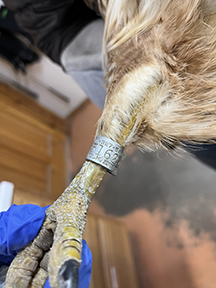A Story of Endurance to the End
Red-tailed Hawk 23-2 was brought to our wildlife hospital after she was found in the rescuer’s yard, unable to fly or even stand. On our initial exam, we noted that she was very thin, had a fractured left leg, and she was indeed not able to put weight on either leg. We also noticed that she was wearing a metal band on her right leg.
Bird banding is a way of tracking wild birds’ populations, movements, and lifespans. Bands are fitted to birds by licensed banders at banding stations or other research facilities, and each band has a number that is unique to its wearer. When we reported the encounter of this Red-tailed Hawk, we learned some interesting information about her life before she came into our care.
Red-tailed Hawk 23-2 was captured and banded in Montana in the fall of 2010. At the time, the bird had adult plumage, indicating that she was at least 2 years old, and she still had yellow eyes, indicating that she was probably only 2 or 3 years old. It was estimated that she had hatched in approximately 2008. When we reported having encountered this bird at our center, we were able to get in touch with the original bander, Robert Domenech of Raptor View Research Institute, who told us that of all the Red-tailed Hawks they have banded, this individual survived the longest amount of time after banding. She was at least in her 15th year of life, quite an impressive lifespan for a wild raptor.
Unfortunately, 23-2’s story ended here in New Mexico. After two days of supportive care, she was stable enough to be sedated for radiographs. In addition to the fractured left tarsometatarsus, her right hip was fully dislocated, and we were able to see that her heart and liver were unusually enlarged. All of these problems, combined with her debilitated body condition and her advanced age, pointed clearly to humane euthanasia being the best option for this bird. While we were sad to not be able to treat and release this bird, we were glad to know that she lived a long life in the wild.







